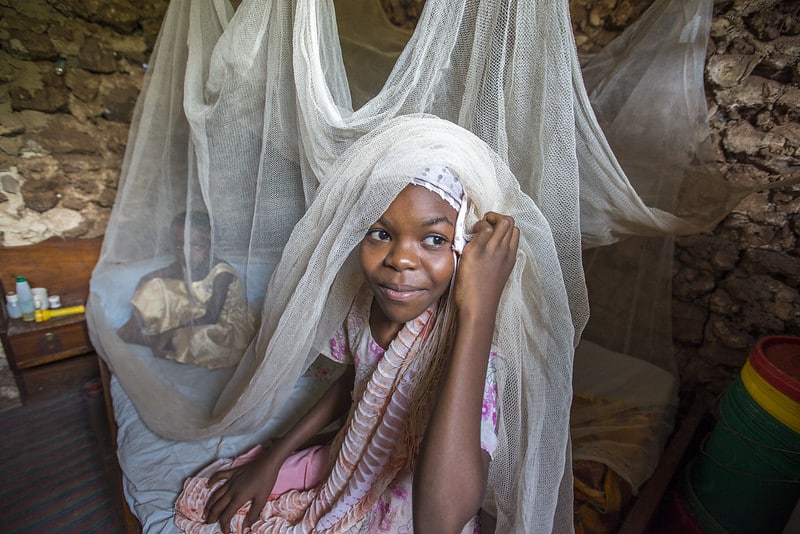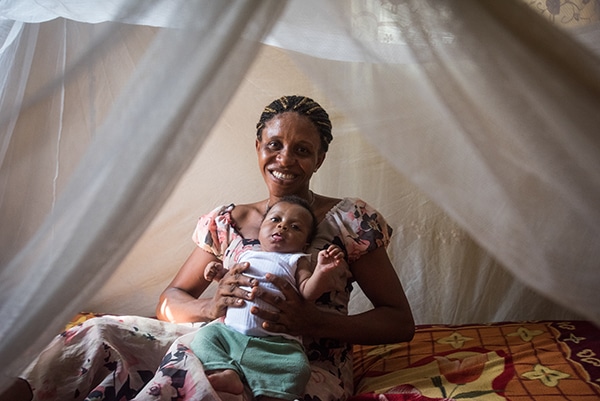To maximize the effectiveness of insecticide-treated bed nets for malaria prevention in sub-Saharan Africa, net use must be a consistent habit every night, throughout the night, most or all of the year, by all household members.
And in order to successfully encourage this life-saving practice, findings from the Johns Hopkins Center for Communication Programs suggest that program planners must convince people that they can use nets effectively and establish positive attitudes about nets.
The findings, based on CCP-led Malaria Behavior Surveys conducted in Cote d’Ivoire, Sierra Leone and Cameroon, were published in December in Malaria Journal.
The manuscript adds to the evidence base showing that considering ideational factors – ways of thinking and how they spread through individual and social interactions – is key to the design of malaria programs where the goal is behavior change, such as increasing routine net use. Using nets regularly has proven critical to the reduction of malaria cases and deaths in recent decades.
One unique feature of the surveys, says CCP’s Stella Babalola, PhD, who led the new study, is that respondents were asked not only if they had slept under a bed net the night before, but how many nights they were used during the previous week. “It’s not enough to use the net tonight and maybe not next week,” she says. “You need to sleep every night under a net.”
Adds Michael Toso, another of the study’s co-authors: “We have spent more than a decade asking whether people slept under a net the previous night. With a behavior that needs to be habitual to be effective, however, it is crucial we understand if people use nets consistently and what factors drive this behavior. The new Malaria Behavior Survey is an important and necessary tool to measure the consistency of this behavior as well as its determinants.”
Another important factor in net use is whether each household has enough bed nets to allow everyone to sleep under one.
Looking at three countries, one thing was clear: People in different regions, even different districts of the same country, may have different attitudes and behaviors regarding net use. “There is not an approach that is one size fits all,” Babalola says. Social and behavior change interventions need to be tailored to what the reasons are for inconsistent net use.
Ideational factors in behavior are based on three dimensions – the cognitive (attitudes, knowledge, perceived risks and norms), emotional (feelings about whether an individual is actually able to affect an outcome on a problem such as malaria) and social (how the behaviors of others influence ours).
The research found that consistent net use in Côte d’Ivoire was 65.4 percent, 72.6 percent in Cameroon and 77.1 percent in Sierra Leone. The study found that while the perception of net use as a community norm was positively linked with consistent use in Cameroon and Côte d’Ivoire, it was not significant in Sierra Leone. Perceived vulnerability to malaria was positively linked with consistent use in Cameroon and Sierra Leone but negatively correlated with the outcome in Côte d’Ivoire.
More research is needed to flesh out why the people of one country – or even one district – behave differently than others. Strategies will have to be adapted to country and regional contexts, where different ideational factors more highly correlate with different behaviors.
All the same, the consistent association of perceived self-efficacy with the use of insecticide-treated nets across the three countries underscores the importance of social and behavior change efforts designed to strengthen the perception that consistent net use is a feasible part of daily life.
“Data from the Malaria Behavior Surveys provide valuable context and are useful in informing the design and implementation of social and behavior change interventions, filling an important formative data gap,” Babalola says.
“Ideational factors associated with consistent use of insecticide-treated nets: a multi-country, multilevel analysis” was written by Stella Babalola, Kuor Kumoji, Grace N. Awantang, Olamide A. Oyenubi, Michael Toso, Samantha Tsang, Therese Bleu, Dorothy Achu, Judith Hedge, David C. Schnabel, Shelby Cash, Lynn M. Van Lith, Anna C. McCartney‑Melstad, Yannick Nkomou, Abdul Dosso, Wani Lahai and Gabrielle C. Hunter.
This work, through CCP’s Breakthrough ACTION project, is funded by the Global Health Bureau of the United States Agency for International Development (USAID) and the U.S. President’s Malaria Initiative (PMI) under the terms of Cooperative Agreement No. AID-OAA-A-17-00017.





